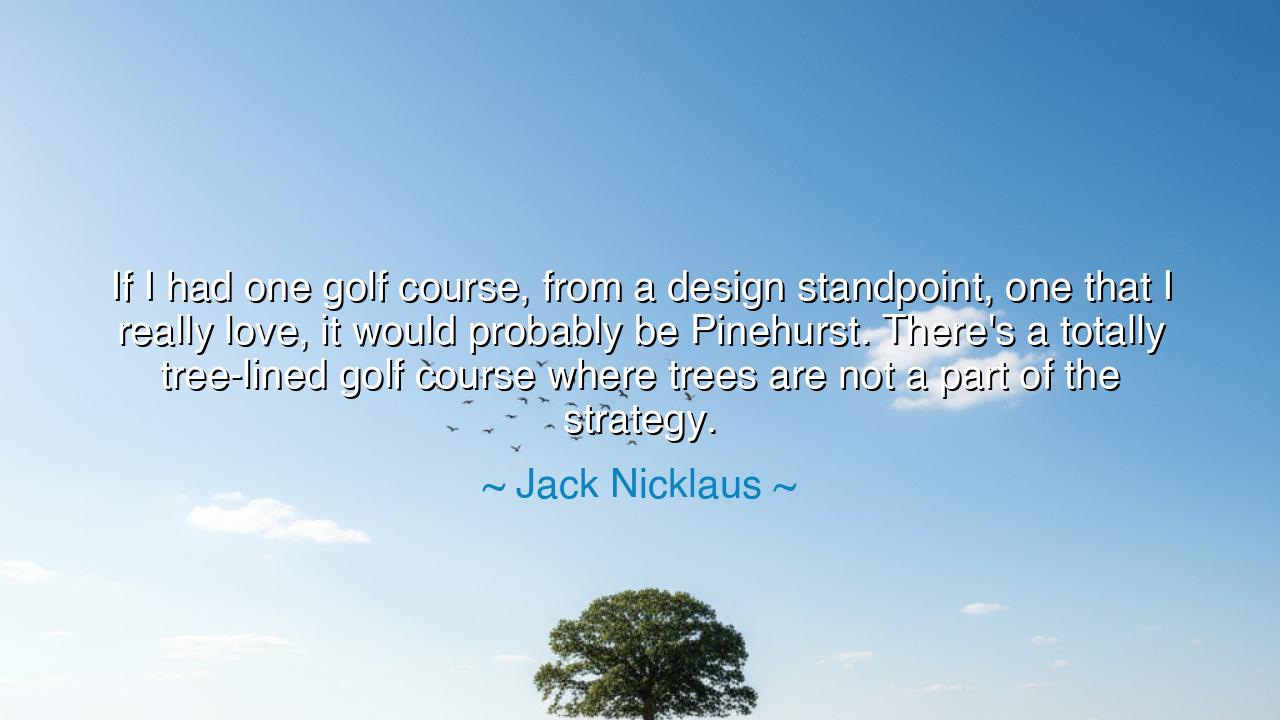
If I had one golf course, from a design standpoint, one that I
If I had one golf course, from a design standpoint, one that I really love, it would probably be Pinehurst. There's a totally tree-lined golf course where trees are not a part of the strategy.






“If I had one golf course, from a design standpoint, one that I really love, it would probably be Pinehurst. There's a totally tree-lined golf course where trees are not a part of the strategy.” – Jack Nicklaus
In these reflective words, Jack Nicklaus, the Golden Bear of golf, speaks not merely of the artistry of course design, but of a deeper truth — the harmony between beauty and purpose, between form and function. His admiration for Pinehurst, a course both embraced by trees and freed from their interference, reveals a philosophy that reaches beyond the fairways. He speaks to the wisdom of restraint, of understanding that not every element which adorns the landscape must command the player’s fate. In this, Nicklaus teaches that true mastery lies not in complexity, but in clarity, not in how much is added, but in how well each part knows its place.
For Pinehurst — especially its famed No. 2 course — stands as a temple of balance. It was crafted by Donald Ross, a man who believed that golf should mirror life: difficult yet fair, elegant yet untamed. Pinehurst is lined with trees, yes, but they are witnesses, not judges. They frame the journey without ruling it. The challenge lies not in escaping their shade but in navigating the subtleties of the ground, the wind, and the mind. Nicklaus saw in that design a lesson: that even in the presence of grandeur and distraction, the true contest remains inward, between vision and execution, between the soul’s calm and the world’s noise.
From a deeper perspective, Nicklaus’s words can be heard as a meditation on discipline and intention. Many in life, like careless designers, clutter their paths with unnecessary obstacles — things that look impressive but serve no purpose. They confuse decoration for depth, busyness for meaning. But the wise — like Ross, and like Nicklaus himself — learn to remove what distracts from the essence. They understand that greatness is achieved not by adding more, but by knowing what to leave untouched. Pinehurst, in this sense, becomes a metaphor for the art of simplicity, the quiet majesty of things rightly placed and rightly balanced.
The ancients knew this truth as well. When the sculptor Michelangelo was asked how he carved David from marble, he replied, “I saw the angel in the stone and carved until I set him free.” So too does the great designer — whether of courses, cathedrals, or lives — remove what is unnecessary so that the essential may breathe. The trees at Pinehurst remain, but they do not command; they are part of the harmony, not the melody. The same must be true of our own lives: the beauty around us should inspire, not entrap; it should shape our vision, not dictate our destiny.
There is also in Nicklaus’s reflection a subtle reverence for humility. The course, though framed by splendor, does not boast of its power. It challenges quietly, teaching patience and precision rather than awe or fear. In an age where noise often masquerades as greatness, Pinehurst stands as a reminder that true excellence whispers. It does not shout. It invites the soul to meet its match, not in spectacle, but in subtlety. Those who walk its fairways — like those who walk the paths of wisdom — must learn to see with inner sight, to discern meaning not in what is loudest, but in what is most lasting.
Thus, the words of Nicklaus become a teaching for all who would create or strive. Whatever field you walk in — be it art, leadership, or life itself — design with intention. Let every act you perform serve a purpose, every word you speak carry weight. Do not be deceived by ornamentation, nor burdened by excess. Know the heart of your craft, and allow space for its natural beauty to breathe. For the greatest designs — and the greatest lives — are not those crowded by ambition, but those aligned with simplicity and truth.
And so, dear reader, when next you face your own Pinehurst — your own challenge surrounded by distractions — remember the wisdom of Nicklaus. Walk with awareness, guided by purpose, not clutter. Let the trees of circumstance stand around you, but do not let them define your path. Find the fairway within your own heart, where focus and serenity dwell. For in that clear space, as on the quiet greens of Pinehurst, lies the secret of mastery — the union of vision and restraint, of nature and will, of beauty and design.






AAdministratorAdministrator
Welcome, honored guests. Please leave a comment, we will respond soon